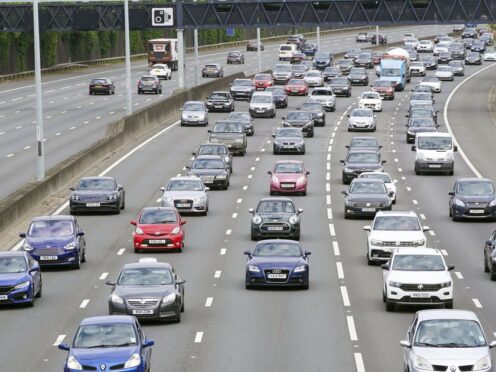A Conservative commitment to ring-fence vehicle tax revenue to fund road projects has been dropped.
The Treasury told the PA news agency that revenue from vehicle excise duty (VED) goes into the Consolidated Fund – a general pot of tax receipts – despite promising to launch a new National Roads Fund (NRF) in 2020.
It insisted VED “is being reinvested” into road schemes.
The RAC said the Government “seems to have done a U-turn and are quietly hoping it goes unnoticed”.
The Department for Transport (DfT) said in 2016 the Government “guarantees that all revenue raised from VED will be allocated to a new National Roads Fund” from 2020/21, adding this would be “underpinned by legislation”.
Then-chancellor Philip Hammond said at his budget in 2018 that £28.8 billion from VED would be invested in the NRF to pay for National Highways’ planned major road schemes between 2020 and 2025.
As part of that announcement, examples given by the Treasury of projects set to be funded included the A66 Trans-Pennine upgrade, the Lower Thames Crossing and the Oxford‑Cambridge Expressway, which have all either been delayed or cancelled.
RAC head of policy Simon Williams said: “We welcomed the Treasury announcement that revenue from vehicle tax in England was to be ring-fenced for future investment in our busiest roads.
“The Government seems to have done a U-turn and are quietly hoping it goes unnoticed.
“We believe the creation of the National Roads Fund would have been a massive step in the right direction as it ensured around £6 billion of the circa £45 billion collected from drivers in all forms of motoring taxation each year would go directly back into the roads that carry the most traffic.”
The DfT announced in October 2023 that money saved from cancelling the northern leg of HS2 would enable it to provide local councils in England with £8.3 billion over 11 years to maintain local roads, including fixing potholes.
Mr Williams described this as “a drop in the ocean considering the years of underinvestment and neglect”.
He urged the Government to ring-fence “a small proportion” of money raised from fuel duty “to ensure our local roads don’t deteriorate any more than they already have”.
A Treasury spokesman said: “The Consolidated Fund receives the proceeds of Vehicle Excise Duty and most other tax revenues, such as those collected by HMRC.
“VED is being reinvested into the English road network between 2020-2025 to fund road enhancement projects.”
